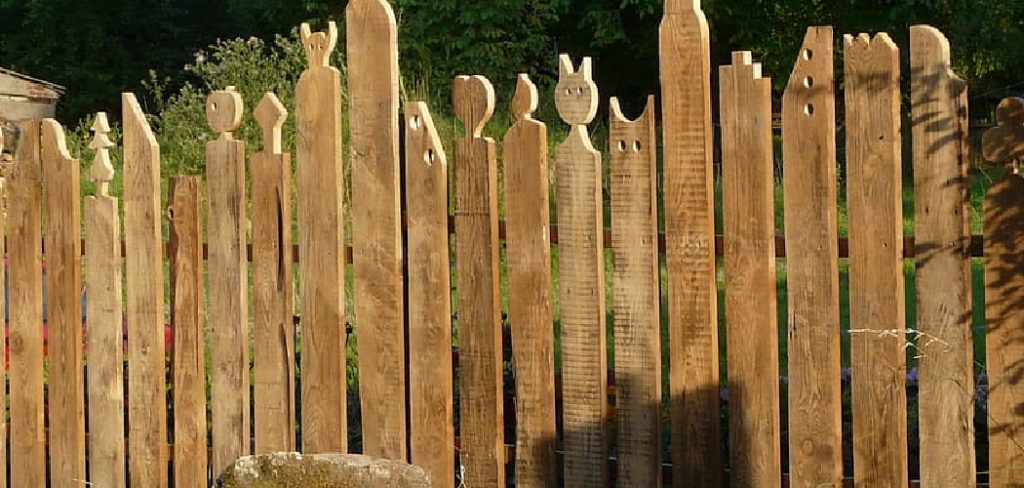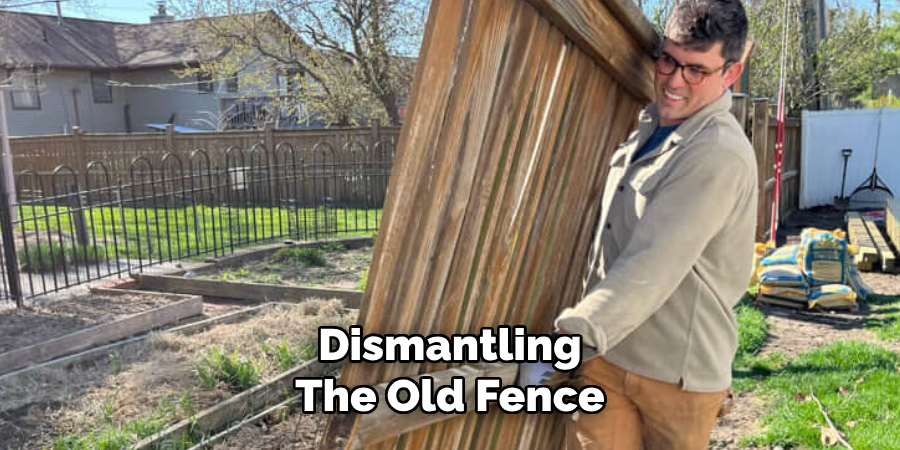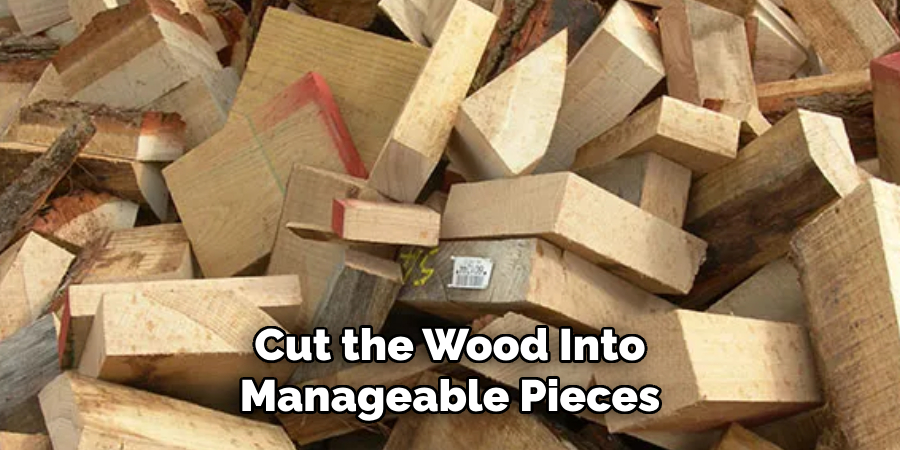Properly disposing of a wood fence is an essential step in maintaining your property and adhering to environmental regulations. Whether you’re replacing an old fence with a new one or simply removing it altogether, it’s important to handle the disposal responsibly.
By understanding your options and following best practices, you can dispose of the wood in an eco-friendly and efficient manner while keeping your community clean and safe. This article discusses how to dispose of wood fences.

Why Dispose of a Wood Fence?
Before diving into the various methods of disposal, it’s important to understand why disposing of your wood fence is necessary. An old or damaged fence can pose safety hazards and become an eyesore in your neighborhood. Additionally, leaving it to rot in your backyard can attract pests and create a breeding ground for mold and bacteria.
Furthermore, disposing of your wood fence responsibly helps reduce waste and landfills. By properly salvaging or recycling the materials, you can minimize the environmental impact while also saving money on landfill fees.
Needed Materials
Work Gloves:
When dismantling your wood fence, it’s important to protect your hands with a pair of work gloves. This will prevent any splinters or cuts from the wood pieces and nails. Choose a thick and durable pair that can withstand tough handling.
Safety Goggles:
Safety goggles are essential when working with power tools or hammers as they protect your eyes from flying debris. Make sure to wear them throughout the process of dismantling your fence to avoid any accidents or injuries.
Pry Bar:
A pry bar is a versatile tool that can be used to remove stubborn nails, loosen tight boards, and dismantle sections of your wood fence. Look for one with a sturdy metal body and comfortable grip for easy handling.
Hammer:
A hammer is a must-have tool for any DIY project, including dismantling a wood fence. It can be used to remove nails and pry apart boards. Choose one with a claw on the back so you can easily pull out stubborn nails.
Saw:
A saw will come in handy when cutting through thick or large pieces of wood. You can either use a hand saw or an electric saw, depending on your preference and the size of your fence. Always wear protective gear and follow safety precautions when using power tools.
Work Gloves:
Wearing work gloves during the dismantling process is important for protecting your hands from splinters, sharp edges, and blisters. Look for durable gloves that fit well and provide a good grip. It’s also helpful to have multiple pairs on hand in case one pair gets worn out or dirty.
Tarp:
After dismantling the old fence, you’ll likely have a lot of debris such as nails, screws, and broken wood pieces lying around. Using a tarp to collect and dispose of these materials can save you time and effort. You can also use the tarp to cover your lawn or plants to protect them from any potential damage during the construction process.
7 Step-by-step Guidelines on How to Dispose of Wood Fence
Step 1: Dismantling the Old Fence
Start by carefully removing the panels, pickets, or boards of the old fence. Use a crowbar, hammer, or power tools to loosen nails or screws that are holding the wood together. Be cautious to avoid damaging the wood if you plan to repurpose or recycle it. Once the panels are removed, proceed to detach the posts, which may require digging them out if they are set in concrete.
Organize the dismantled materials into separate piles based on their condition and usability, which will make disposal or recycling easier later on. Always wear gloves and safety glasses during this process to protect yourself from splinters and debris.

Step 2: Separate Materials
Once the fence has been dismantled, carefully sort the materials into distinct categories. Separate wood, metal, and any other materials such as concrete or plastic components. Check each piece for nails, screws, or other hardware, and remove them with the appropriate tools to ensure the materials are safe to handle. Inspect the wood to identify sections that can be reused or recycled, setting aside any pieces that are damaged or beyond repair for disposal.
Properly grouping materials at this stage will streamline recycling or repurposing efforts and maintain an organized workspace.
Step 3: Rent a Dumpster or Hire a Waste Management Company
To handle the disposal of materials that cannot be reused or recycled, consider renting a dumpster or hiring a professional waste management company. Renting a dumpster provides a centralized location for collecting and discarding non-reusable debris, ensuring the workspace remains safe and free of clutter.
When choosing a waste management company or dumpster service, research local providers to find one that aligns with your project’s scale and specific needs, such as handling specific materials or providing eco-friendly disposal options. By organizing waste removal efficiently, you can focus on completing the project while adhering to local waste disposal regulations.
Step 4: Cut the Wood Into Manageable Pieces
Once the materials are sorted and the workspace is clear, the next step is to cut the wood into manageable pieces. Begin by measuring and marking the wood according to the project specifications, ensuring precise cuts. Use the appropriate tools, such as a handsaw, circular saw, or miter saw, depending on the type and thickness of the wood.
Prioritize safety by wearing protective gear, including safety glasses and gloves, and keeping your hands clear of the cutting area. Work methodically to achieve clean cuts, which will make assembly easier and improve the overall quality of the finished project. Remember to dispose of wood scraps responsibly or set them aside for potential reuse.

Step 5: Recycle or Reuse if Possible
Once your project is complete, assess any leftover materials for potential recycling or reuse. Wood scraps can often be repurposed for smaller projects, repairs, or even creative crafts. If some pieces are not usable, check with local recycling centers to see if they accept wood waste.
By recycling or reusing materials, you not only reduce waste but also contribute to environmentally sustainable practices. Taking the time to manage leftover materials responsibly reflects a commitment to both efficiency and care for the environment.
Step 6: Dispose of Treated Wood Properly
Treated wood requires special care when it comes to disposal due to the chemicals used to enhance its durability and resistance to decay. Never burn treated wood, as doing so can release harmful toxins into the air. Instead, consult your local waste management facilities to determine the proper way to discard it.
Some facilities may have designated drop-off sites for treated wood or specific guidelines for safe disposal. By following these procedures, you help prevent environmental contamination and ensure that hazardous materials are managed responsibly.
Step 7: Clean Up
After completing the project, take the time to thoroughly clean up the work area. Remove any leftover debris, nails, and tools to ensure the space is safe and tidy. Sweep up sawdust and other small particles to prevent them from blowing into nearby areas or waterways.
Properly store tools and unused materials for future use, making the working environment organized and accessible for the next project. A clean area not only reflects a job well done but also minimizes risks and promotes safety for everyone.

Following these steps on how to dispose of wood fence will not only make your construction project a success, but it will also leave a positive impact on the environment and community. By implementing sustainable practices and reducing waste, you are contributing to the overall well-being of our planet.
Additional Tips
- Consider donating or repurposing old fence materials instead of throwing them away. They could be used for other DIY projects or even donated to organizations in need.
- Research and utilize eco-friendly alternatives for wood fences, such as bamboo or recycled plastic.
- Properly maintain your new fence to prolong its lifespan and minimize the need for replacement materials.
- Educate yourself and others on the importance of sustainable construction practices and their impact on the environment. Together, we can make a positive difference in our communities and beyond.
Remember to always prioritize safety, efficiency, and sustainability when working on any construction project.
Frequently Asked Questions
Q1: How Can I Ensure That My Construction Project is Environmentally Friendly?
A1: There are several ways to make your construction project more environmentally friendly, such as using sustainable materials, implementing energy-efficient designs, and properly disposing of waste. It is also important to consider the long-term impact of the project on the surrounding environment. Consulting with environmental experts and incorporating sustainable practices into the construction process can help ensure a more eco-friendly project.
Q2: What Safety Measures Should I Take Before Starting a Construction Project?
A2: Prior to starting any construction project, it is important to conduct a thorough safety assessment of the site. This may include identifying potential hazards, implementing proper safety protocols and procedures, and providing adequate training for all workers on the project. It is also crucial to regularly inspect equipment and machinery for any malfunctions or defects that could pose a danger to workers.

Q3: How Can I Improve Efficiency on My Construction Site?
A3: There are several ways to improve efficiency on a construction site, including implementing technology and utilizing best practices.
One way to improve efficiency is by utilizing construction management software. This type of software can help streamline processes, track project progress, and identify areas for improvement. It also allows for better communication between team members and helps reduce errors and delays.
Conclusion
Removing an old fence or deck may seem like a daunting task, but with the right tools and methods, you can get rid of it efficiently and responsibly. Remember to prioritize safety and proper disposal methods to ensure a smooth and successful project.
And don’t forget, whether you choose to reuse or recycle the materials, you’re also doing your part in reducing waste and promoting sustainability. Thanks for reading this article on how to dispose of wood fence. Exploring different wood fence ideas can help you find the perfect balance of privacy, style, and durability for your outdoor space. Happy DIY-ing!
About the Author
Adrian Green, a lifelong woodworking enthusiast, shares his passion for the craft through The Woodenify Blog. With a foundation built on years of hands-on experience in his father’s woodworking shop, Adrian is dedicated to helping others learn and grow in the world of DIY woodworking. His approach to woodworking combines creativity, practicality, and a deep appreciation for the art of building with your own hands. Through his blog, he inspires individuals of all skill levels to embark on their own woodworking journeys, creating beautiful, functional pieces of furniture and décor.
Professional Focus
- Specializes in DIY woodworking projects, from furniture to home décor.
- Provides step-by-step guides and practical tutorials for woodworkers of all skill levels.
- Dedicated to helping readers build confidence and skill through easy-to-follow instructions and tips.
- Passionate about fostering a community of makers who can share, learn, and grow together.
Education History
- University of Craft and Design – Bachelor of Fine Arts (BFA) in Woodworking and Furniture Design
- Woodworking Apprenticeships – Extensive hands-on training with skilled craftsmen to refine carpentry and furniture making techniques.
- Online Courses & Masterclasses – Continued education in advanced woodworking techniques, design principles, and specialized tools
Expertise:
- DIY woodworking, carpentry, furniture making, and home décor projects.
- Creating accessible tutorials and guides for beginner to advanced woodworkers.
- Sharing the joys and satisfaction of woodworking, from raw materials to finished products.
